The Real-Time Agenda Technique
I was enjoying lunch at a technology conference with a group of CTOs from high-powered companies when the conversation turned from blockchain to meetings.
It’s funny how that always happens.
First, we heard about the awful meetings held at a large manufacturing company. Then, it was the CTO for an NFL team’s turn.
“My team meetings are terrible!” he exclaimed. “My problem is my co-manager. If it were up to me, we’d have an agenda for every meeting and a report afterwards. I’m an orderly type of guy. Like, you should see my sock drawer. It’s amazing! But my partner thinks that’s all too formal and stuffy, so whenever I bring an agenda he just ignores it. Then of course the meetings always go long, we never get through what we wanted to talk about, and we just end up having more meetings to hash it out again. I guess I should put my foot down and start forcing him to use an agenda.”
He sighed.
There are easily five things you could pick out of that statement as problems worth addressing, but the big one is the conflicting beliefs between the managers. One wants to “follow rules,” the other sees rules as needless constraints.
“Have you heard of a real-time agenda? Or Lean Coffee?” I asked. He hadn’t, so I explained the concept.
What is a Real-Time Agenda?
The basic idea is all right there in the name.
A real-time agenda is a process for co-creating, prioritizing and discussing a list of topics in real time.
A real-time agenda isn’t a type of meeting. It’s a technique that you can use in many different types of meetings. I consider it one of the master techniques, because it’s useful, extremely adaptable, widely loved, and it pops up all the time. You’ll find variations of real-time agendas by many names: examples include Lean CoffeeTM, IDS, Open Space, and Unconference. You’ll also find a few references that simply call it a real-time agenda—straight up neat, no ice.
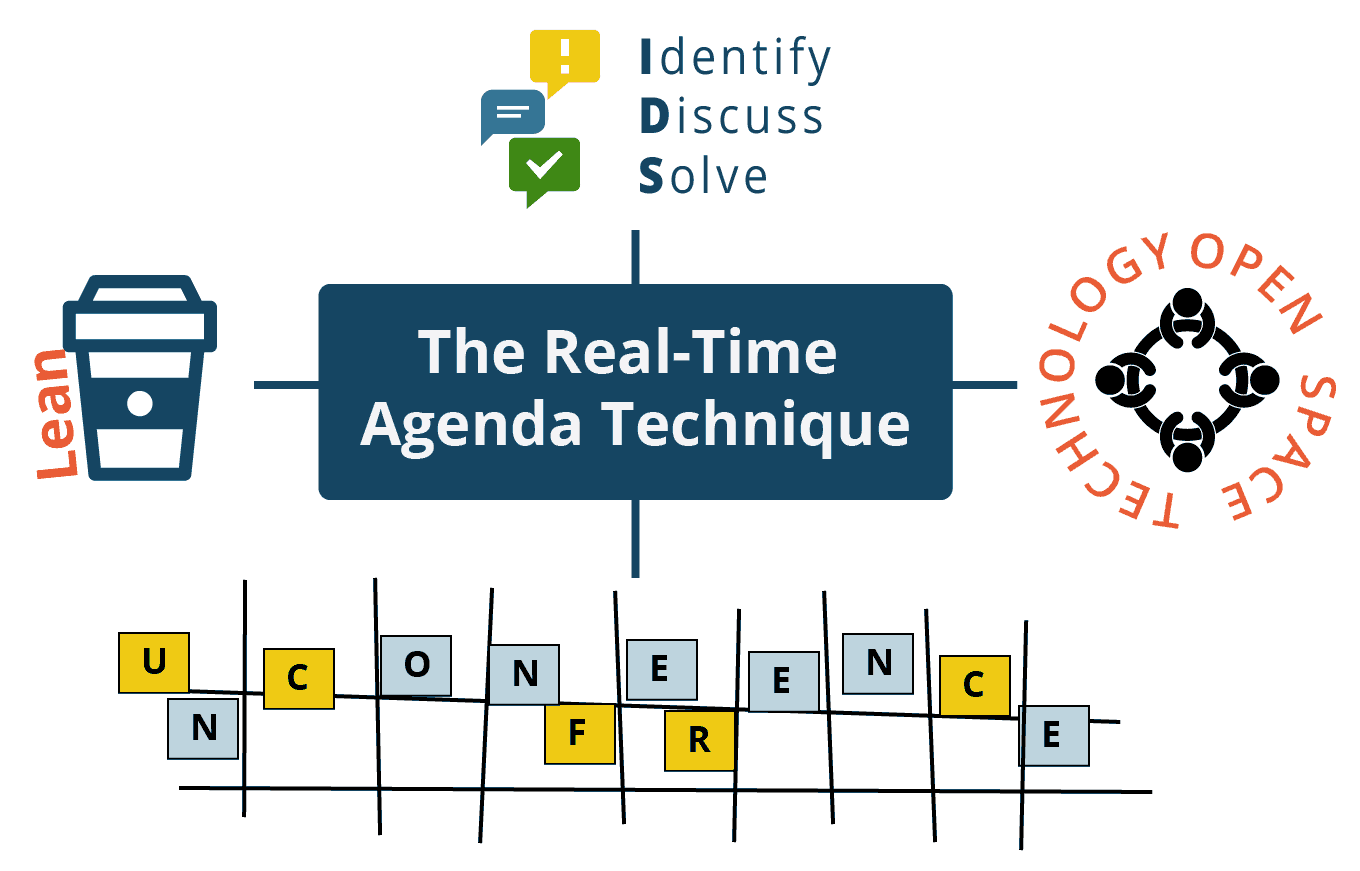
We’ll look at these variations below and provide some examples. First, though, let’s start with the core technique.
The Basic Real-Time Agenda Process
- The group creates a list of topics they could discuss. Everyone is encouraged to add topics to this list.
- The group prioritizes the list to identify which topics they wish to discuss first.
- The group discusses the top-priority topic. Then they move on to the next topic, and so on, until they run out of time.
- The group reflects on what they’ve accomplished, confirms next steps, and closes the meeting.
Benefits of a Real-Time Agenda
This process meets all the criteria for increasing PMQ (Perceived Meeting Quality).
- Everyone actively participates. These are their topics, discussed in an order they choose, by them.
- The process uses time boxing, making it easier to start and end on time.
- Assuming the group knows they’ll be using a real-time agenda process, they will know what to expect in advance and then work together to meet their own expectations. A key element of satisfaction in any arena has to do with whether we got what we expected to get, and this process gives meeting conveners a way to set those expectations without dictating discussion topics.
Check out this enthusiastic praise for the technique from a description of the Lean Coffee variation.
Power to the People
To sum up, I’ve found that Lean Coffee meetings are much more effective and enjoyable because we’ve turned the control back over to those who can best use it. No longer is there one person dominating the conversation. Gone is the rigid agenda that must be adhered to. Now the invitees run the show, as it should be.
The group has buy-in since they set the topics and vote on the “agenda”. The discussions flow more naturally, going where they need to and staying away from the unnecessary. Everyone has a stake in keeping the meeting on point, and ownership & engagement levels have gone through the roof.
Victor ‘Vic’ Bonacci, agilecoffee.com
Now, we could stop right here and you could probably figure out ways to use that basic process in your meetings. Personally, I find examples helpful.
Some of the questions I had the first time I saw the basic steps:
- How exactly does the group make the list?
- How do they prioritize?
- How long do they spend on any given topic?
- How do they know they’re done with a topic and can move on to the next one?
The answers to all of the above depend on the variation you’re using. Let’s dive into the examples.
Real-Time Agendas Within Larger Team Meetings
Weekly team meetings may be highly structured or they may be entirely free-form like the ones my luncheon partner suffered. There is a natural tension between these dynamics: a good structure helps create predictability and momentum, but doesn’t necessarily accommodate the need to discuss urgent topics. By contrast, not having a structure provides ultimate flexibility to address whatever you think matters most at the moment, but it fails in every other regard.
Many business management gurus advocate a blended approach. The weekly meetings they teach to leadership teams include several pre-defined topics that get covered quickly, such as current performance numbers, and then they dedicate the bulk of the meeting to a real-time agenda.
Patrick Lencioni’s Real-Time Agenda
It was Patrick Lencioni, the author of Death by Meeting (2004) and The Five Dysfunctions of a Team (2002), who introduced me to the term “real-time agenda”. He advocates this practice as part of a weekly leadership team meeting.
First, go around the table and give every member of the team 30 seconds to report on his or her three top priorities for the coming week. Even a team of twelve can do this in 6 minutes.
Then review your team scorecard and rate your objectives to decide what to focus on for the rest of the meeting.
from page 23 in this Table Group workshop guide
The EOS Level 10 Meeting
Gino Wickman’s Entrepreneurs Operating System, detailed in his book Traction, credits much of its effectiveness to a weekly leadership team meeting structure dubbed the Level 10.
The Level 10 meeting starts with announcements, a scorecard review, and a few other short regular items, then devotes the bulk of the meeting to a real-time agenda focused specifically on solving immediate operational issues. They call this process IDS:
- Identify: the team maintains a running list of open issues. They add an issue to the list any time they’re off plan (like when they miss a revenue target, for example) and these issues stay on the list until they’re addressed. Team members also add any other issue they feel they should discuss. Issues that aren’t addressed in the current meeting stay on the list as possible topics for next week’s meeting.
- Discuss: the team talks about the issue until they are sure they understand it.
- Solve: the team determines how they’ll work to resolve the issue and assigns an action item to the person responsible for the next step.
Here’s a quick video of Gino Wickman explaining the Level 10 meeting and his IDS variant of the real-time agenda.
Lucid’s Weekly Leadership Team Meeting Agenda Template
Here at Lucid, we’re big fans of this mix of structure and real-time work for weekly team meetings. You’ll see our variation on this theme in this meeting template from our set of 4 Leadership Team Meeting Agendas.
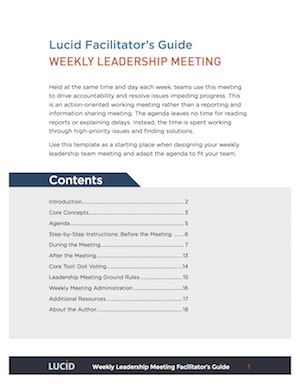
The Real-Time Agenda on its Own
As the examples above show, you can run a real-time agenda as one part of a larger meeting. Most people, however, learn this technique as way to run a whole meeting from start to finish.
Depending on the circles in which you circle, your first real-time agenda experience was probably one of the following:
- Lean Coffee: suitable for smaller groups and shorter meetings
- Open Space: a way to run larger community-of-practice events and workshops
- Unconference: inspired by Open Space, very similar in many ways, and popular with the technology crowd
The most well-known of these is:
Lean Coffee
Lean Coffee was named and popularized by Jim Benson and Jeremey Lightsmith in 2009. They were looking to create a community group that would get together to talk about Lean methods over coffee (hence the name) without all the overhead of speakers and organizing committees. You can read all about it on the Lean Coffee website.
Here’s a simplified short version of how to run a meeting using Lean Coffee.
How to Run a Lean Coffee
Setup:
Create a space with 3 columns titled To Discuss, Discussing, and Done or something similar.
- Create list of possible topics.
Everyone writes possible topics on sticky notes or online and adds them to the To Discuss column. You may invite people to briefly explain the topics they’ve added. - Prioritize topics using Dot Voting.
Give each person 3 votes. The topics with the most dots go to the top of the list. - Discuss topics in priority order.
Work your way through the topics until you run out of time.
And here’s a nice visual summary Gerry Kirk posted to Slideshare:
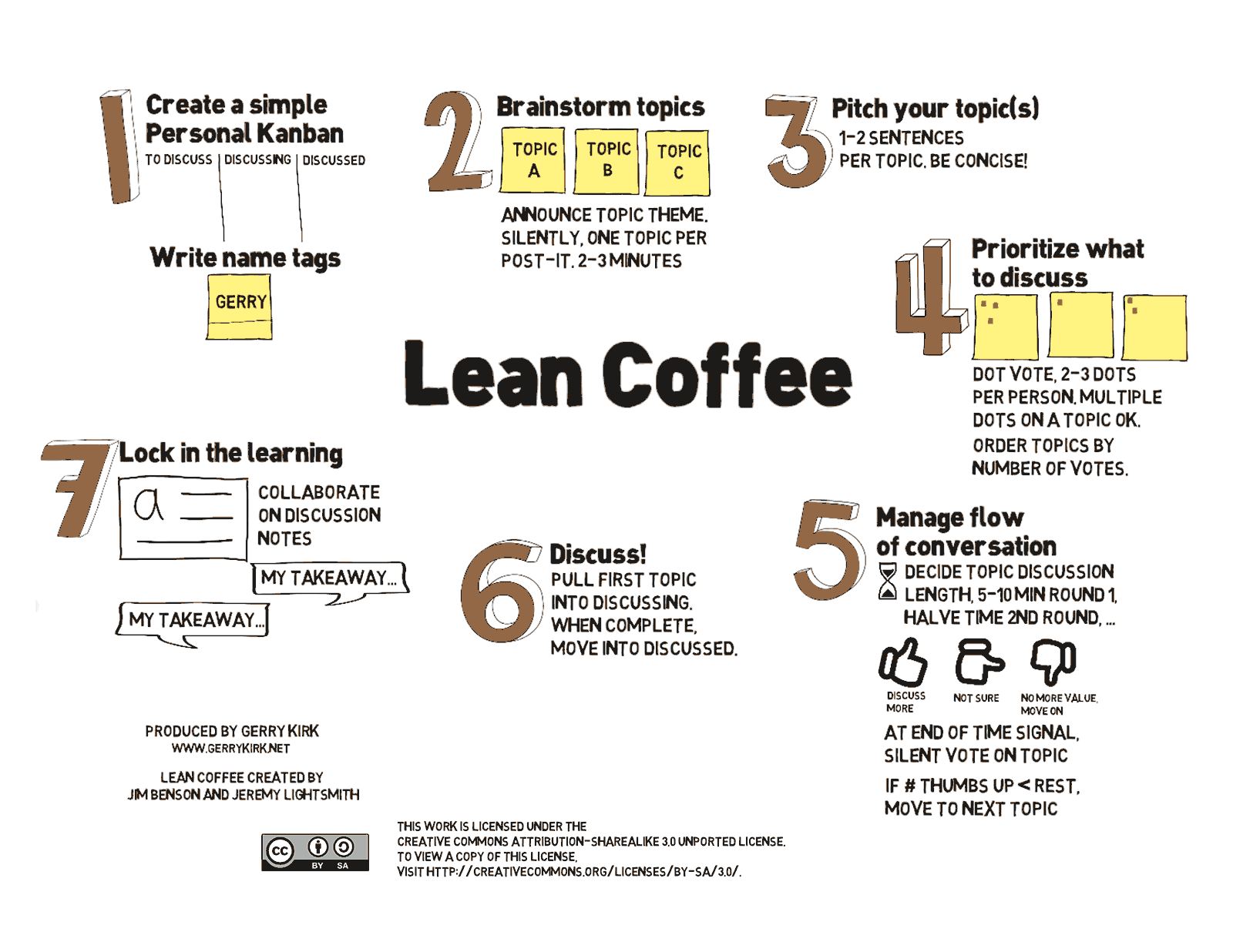
The Lean Coffee group originally met in person. They used sticky notes posted on a wall for proposing topics and managing the process.
There are lots of ways to run this process online too. Diana Larsen uses Lean Coffee Table with her cohort of Agile Fluency coaches. I know some groups use Trello, and others use one of the visual collaboration systems from our mega list of brainstorming tools. So many options!
I’ve also participated in a Zoom video conferencing call that ended with a “Lean Coffee moment.” In that call, people posted topics in chat. The facilitator then read these out, and we voted by holding up 1, 2, or 3 fingers for each topic. After adding up the fingers, we had our topic winners!
Weekly Cadence Meetings Using a Real-Time Agenda
Lean Coffee was originally intended to be a technique used in Community of Practice meetings, and specifically by practitioners of Lean methods. Since then, it’s been widely co-opted for all kinds of meetings.
In their 2014 book Let’s Stop Meeting Like This, Dick and Emily Axelrod describe a healthcare clinic that runs their weekly staff meeting using a real-time agenda. The clinic keeps a large whiteboard in their staff meeting room. People can add possible topics to the To Discuss column at any time during the week. During the meeting, they prioritize, discuss, and close out as many topics as they can in the time available.
When they were getting started, the team at NuCognitive followed a similar practice. Daniel Walsh, one of the founders of NuCognitive, offered this bit of advice for anyone considering a real-time agenda for their team meetings.
It’s great, and for the most part, it means we’re always talking about the most important topics every week.
You do have to be careful of the majority overpowering minority interests. We had one person who kept bringing up the same topic week after week, but it never got the votes it needed to make it on our list. Luckily, they spoke up about getting repeatedly overruled after a few cycles. Even though the rest of us didn’t think it was a priority, it was clearly important to them. The majority rule prioritization process made it really easy to discount a minority opinion. When we talked about it, though, we all saw why we needed to focus some time there.
Teams may want to consider adding a working agreement or rule for this risk. For example, any topic that’s added to the list three weeks in a row automatically gets prioritized.
Daniel Walsh, founder of NuCognitive
Here at Lucid, we use a more structured approach for our Leadership Weekly Team Meeting, but the marketing team uses this technique. The weekly Marketing Working Session is a full Cadence meeting built on top of a lightweight version of the real-time agenda process.
The Lucid Marketing Team’s Weekly Working Session
Purpose: To select the most promising marketing opportunities each week and figure out how to seize them.
Desired Outcomes:
- A list of opportunities to pursue in the coming week
- Defined next steps with owners and due dates
Process:
- Welcome
Every meeting at Lucid starts with a welcome. It’s nice to say hi. See our post on the underlying structure of effective meetings. - Create a list of possible Marketing projects to explore.
In our case, we add these to the Marketing “parking lot,” where we can also see any topics added in previous meetings. - Select the top 2 or 3 topics.
We limit the topics because in this working session, we always come up with way more great ideas than we have people to do the work. This limit helps us focus on developing programs we can execute. - Discuss each topic to resolution.
We let this take as long as it needs. We consider a topic resolved when we have concrete action items assigned for the next step OR we’ve realized we’re not ready to give it our attention and have shunted it back to the parking lot. Most of our working sessions last under an hour, but a few have taken a full 90 minutes—our time limit for any meeting. - Confirm action plans.
Finally, we spend a few short minutes making sure we’ve clearly captured the action items.
Our team is distributed, so we run this meeting using Lucid Meetings (natch). Here’s a quick video showing what that looks like.
For Conferences and Events: Open Space and Unconference
Open Space, or Open Space Technology, expands the real-time agenda concept to work in large group, larger format settings.
Open Space events begin with an invitation and an opening circle. People are then asked to propose the topics they want to discuss, just as they do for all real-time agendas.
Topics are typically posted on a wall, forming a topic “Marketplace”. Then, instead of dot voting or some other kind of prioritization, people sign up to join in the discussion for the topics they find most compelling.
After everyone has signed up, the larger group breaks into smaller groups, each of which discuss the topics they’ve elected to join. Following several rounds of discussion, the group reconvenes in a closing circle.
Open Space practitioners and consultants use this technique specifically to help groups work through challenging issues.
Open Space is appropriate in any situation where there is a real business issue to be solved marked by High levels of complexity, in terms of the issues to be resolved, High levels of diversity in terms of the people needed to solve it, High levels of conflict (potential or actual), and there is a Decision time of yesterday. Given these conditions, Open space is not only appropriate, but always seems to work.
Harrison Owen, Opening Space for Emerging Order
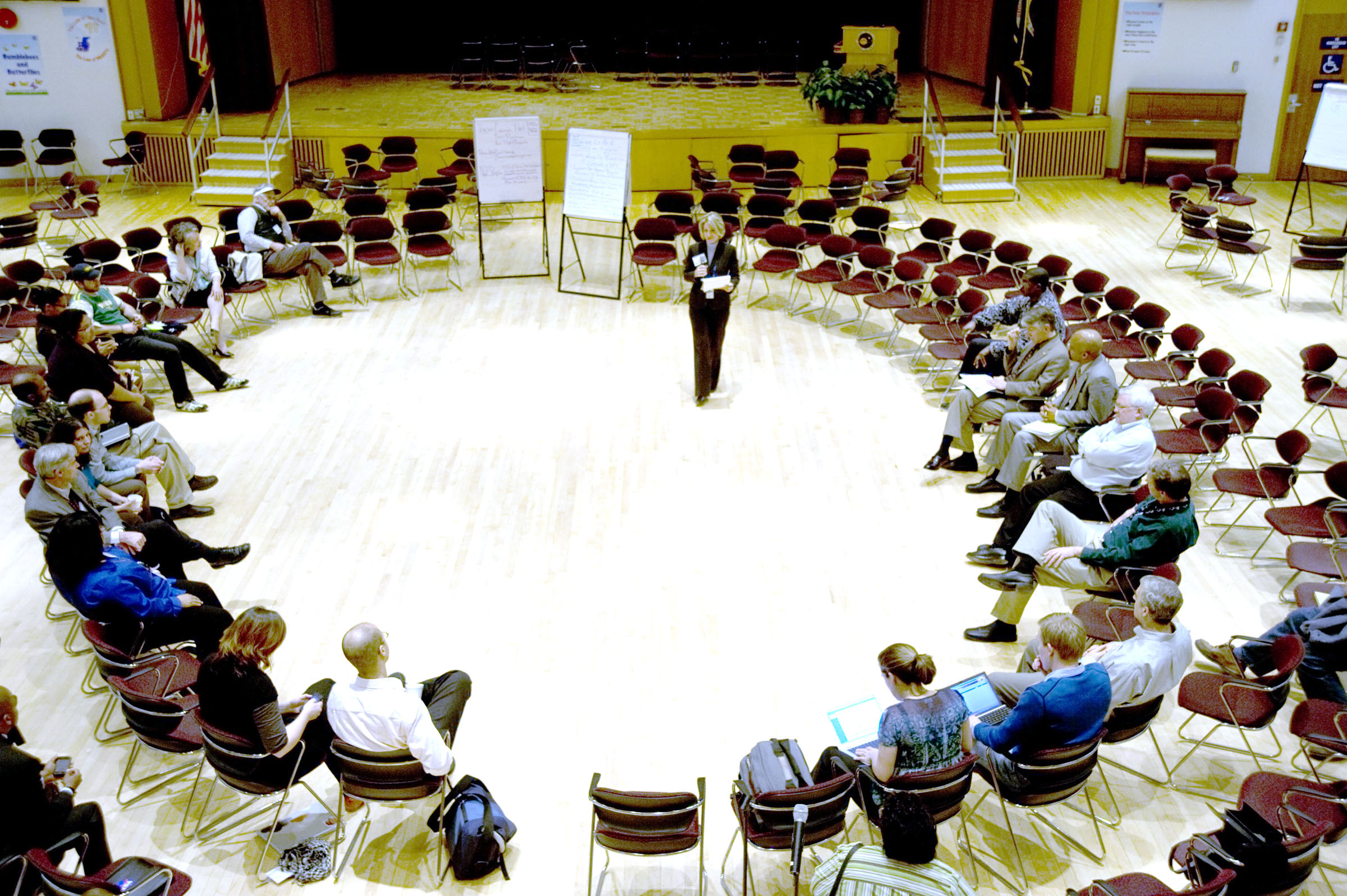
Given this context, you can begin to imagine the rich practice that Open Space inspires. People bring Open Space concepts not only to meetings, but to the design of their overall organizations and personal lives. While the core practices are meeting practices used to convene diverse groups around challenging topics, the wider body of Open Space practice extends well beyond the meeting.
Read more about Open Space on OpenSpaceWorld.org.
The Unconference works very similarly to an Open Space event, minus the lofty ambitions. Unconferences are common in technology-centered Communities of Practice, either as the full event or as a portion of a larger event.
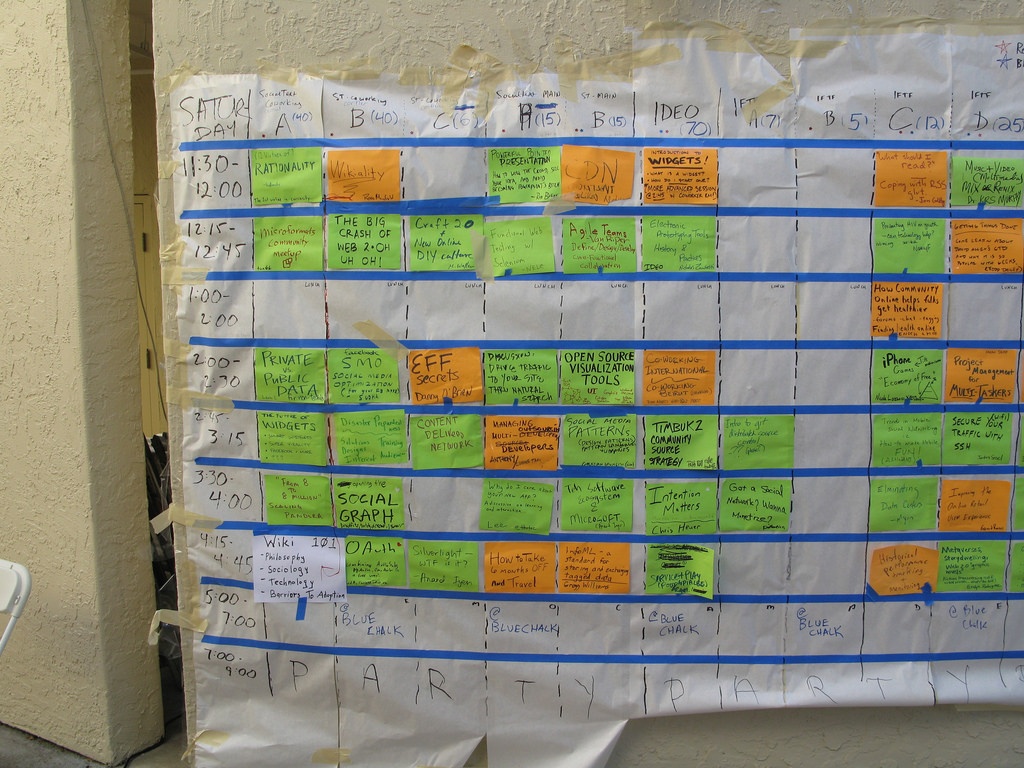
For example, the recent Dazzlecon conference I attended featured speakers in the morning of the first day, and an Unconference in the evening. This wasn’t specifically a technology event, but we enjoyed a healthy helping of technophilia. Many people reported finding the Unconference the most rewarding portion of the event.
ProductCamp, another local Portland event I always try to attend and always miss, is organized entirely as a full day Unconference.
The Unconference is Open Space adapted to emphasize learning and sharing, rather than exploration of deep issues, in Communities of Practice.
Most Unconferences and Open Space events abide by these shared principles.
Open Space/Unconference Principles
- Whoever comes is the right people …reminds participants that they don’t need the CEO and 100 people to get something done, you need people who care. And, absent the direction or control exerted in a traditional meeting, that’s who shows up in the various breakout sessions.
- Whenever it starts is the right time …reminds participants that “spirit and creativity do not run on the clock.”
- Wherever it is, is the right place …reminds participants that space is opening everywhere all the time.
- Whatever happens is the only thing that could have, be prepared to be surprised! …reminds participants that once something has happened, it’s done—and no amount of fretting, complaining or otherwise rehashing can change that. Move on. The second part reminds us that it is all good.
- When it’s over, it’s over (within this session) …reminds participants that we never know how long it will take to resolve an issue, once raised, but that whenever the issue or work or conversation is finished, move on to the next thing. Don’t keep rehashing just because there’s 30 minutes left in the session. Do the work, not the time.
Law of two feet
If at any time during our time together you find yourself in any situation where you are neither learning nor contributing, use your two feet, go someplace else.
Source: WikiPedia article on Open Space Technology, summarizing Harrison Owen
These events typically take place in a real-world place; this was intended to be a face-to-face meeting technique as you can see from the pictures above.
That said, new technology has emerged that supports Open Space events online. Check out this video from our friends at QiQo Chat.
What, So What, Now What?
Let’s wrap this up. I’ve covered the What. To recap:
- The Real-Time Agenda is a master meeting technique where everyone present co-creates the topics for discussion during the meeting.
- Real-time agendas work. People find the process engaging and can use it to achieve tangible outcomes quickly.
- Real-time agendas can be used as one part of a structured team meeting, as an entire meeting, or even as the organizing principle for a multi-day conference.
- The most recognizable name-brand variations of the Real-Time agenda include: Lean Coffee, Open Space Technology, and the Unconference.
- Real-time agenda techniques work for face-to-face meetings and remote meetings. In either situation, you need the right supplies (sticky notes or technology).
So What?
At every scale, real-time agendas get more people involved and make sure the group is dealing with topics that are meaningful to them. This is particularly powerful when:
- The team has challenges with unequal leadership or power dynamics. See the story at the top of this post for an example.
- You have more you could talk about than you have time; your team needs a way to focus on what’s most important.
- You’re facing a complex situation where you know you don’t have all the answers, and you could all benefit from the wisdom of your crowd.
- You want to convene a group of like-minded folks in discussion, but you don’t want to arrange speakers or take on anything too formal.
- Whatever you’re doing now isn’t working, and you need to try something new. This is a proven, safe experiment.
Ever find yourself in any of these situations? I know I sure do! When I’m faced with one of these challenging moments, when I don’t know which topic the group needs to address first or how we’ll get to a solution, I find the real-time agenda technique both supremely helpful and deeply reassuring. It means I don’t have to know the answer; I’ve got a whole group of people there to work it out together.
Now what?
First, if you haven’t used this technique before, I recommend attending an event near you. See how it works, notice how it feels, and think about how what you experience either fits or disagrees with what you’ve read here.
Then, I invite you to consider the meetings in your world. Are there places where a real-time agenda could come in handy? Perhaps whole meetings that lack structure that could be improved with this technique? If so, give it a try!
Finally, if you have come to know and love one specific kind of real-time agenda, I invite you to deepen your practice. If you know Lean Coffee, explore Open Space. If you know Open Space, consider IDS and the more tactical variations. If you know sticky notes, explore technology.
Then, share what you’ve learned! This is a short article on a deep topic. I look forward to deepening my practice by learning from all of you in the comments below.



